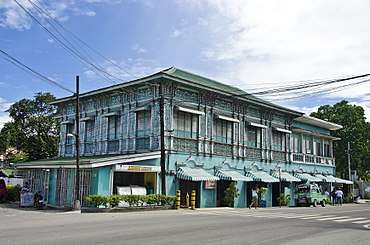Carcar
Carcar, officially the City of Carcar (Cebuano: Dakbayan sa Carcar; Tagalog: Lungsod ng Carcar), is a 5th class city in the province of Cebu, Philippines. According to the 2015 census, it has a population of 119,664 people.[3]
Carcar | |
|---|---|
| City of Carcar | |
 Carcar from the bell tower of St. Catherine of Alexandria church | |
 Seal | |
 Map of Cebu with Carcar highlighted | |
OpenStreetMap OpenStreetMap 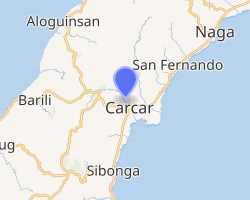
| |
.svg.png) Carcar Location within the Philippines | |
| Coordinates: 10°07′N 123°38′E | |
| Country | |
| Region | Central Visayas (Region VII) |
| Province | Cebu |
| District | 1st district of Cebu |
| Founded | 1599 |
| Cityhood | 2007 |
| Barangays | 15 (see Barangays) |
| Government | |
| • Type | Sangguniang Panlungsod |
| • Mayor | Mercedita R. Apura |
| • Vice Mayor | Nicepuro L. Apura |
| • Congressman | Eduardo R. Gullas |
| • Electorate | 74,303 voters (2019) |
| Area | |
| • Total | 116.78 km2 (45.09 sq mi) |
| Population (2015 census)[3] | |
| • Total | 119,664 |
| • Density | 1,000/km2 (2,700/sq mi) |
| • Households | 26,585 |
| Economy | |
| • Income class | 5th city income class |
| • Poverty incidence | 21.39% (2015)[4] |
| • Revenue (₱) | 459,824,796.59 (2016) |
| Time zone | UTC+8 (PST) |
| ZIP code | 6019 |
| PSGC | |
| IDD : area code | +63 (0)32 |
| Climate type | tropical climate |
| Native languages | Cebuano Tagalog |
Carcar City is bordered to the north by the town of San Fernando, to the west are the towns of Aloguinsan and Barili, to the east is the Cebu Strait, and to the south is the town of Sibonga.
Carcar lies within Metro Cebu area.[5]
History
Carcar was known as "Sialo" since before the Spanish colonization. It became a municipality in 1599. Carcar is considered one of the oldest towns in Cebu, with its Spanish influence lasted more than 300 years ago.
- Cityhood
Geography
Carcar is located 40 kilometres (25 mi) south of Cebu City. It has a land area of 116.78 square kilometres (45.09 sq mi).
- Topography
The land is generally level with less than 18% slope comprising 78.7% of the total land area. Areas with slopes ranging from 18 to 50% cover 19.3% of the total land area and those over 50% slope comprise approximately 1.9%. The highest recorded elevation is a little over 660 metres (2,170 ft) above sea level, located within the barangay of Napo.
- Soil type
The municipality has five dominant soil types namely: Faraon Clay, Steep Phase, the Lugo Clay, the Mandaue clay loam & the Hydrosol type.
Barangays
Carcar comprises 15 barangays:
| PSGC | Barangay | Population | ±% p.a. | |||
|---|---|---|---|---|---|---|
| 2015[3] | 2010[6] | |||||
| 072214001 | Bolinawan | 9.1% | 10,881 | 10,852 | 0.05% | |
| 072214002 | Buenavista | 2.2% | 2,662 | 2,294 | 2.87% | |
| 072214003 | Calidngan | 2.7% | 3,258 | 2,953 | 1.89% | |
| 072214004 | Can‑asujan | 7.6% | 9,114 | 7,845 | 2.90% | |
| 072214005 | Guadalupe | 10.6% | 12,641 | 10,633 | 3.35% | |
| 072214006 | Liburon | 6.4% | 7,606 | 6,749 | 2.30% | |
| 072214007 | Napo | 5.4% | 6,427 | 6,344 | 0.25% | |
| 072214008 | Ocana | 7.8% | 9,361 | 8,507 | 1.84% | |
| 072214009 | Perrelos | 11.8% | 14,129 | 12,901 | 1.75% | |
| 072214012 | Poblacion I | 9.1% | 10,919 | 8,996 | 3.76% | |
| 072214013 | Poblacion II | 2.2% | 2,680 | 2,432 | 1.87% | |
| 072214014 | Poblacion III | 5.8% | 6,898 | 5,763 | 3.48% | |
| 072214015 | Tuyom | 5.1% | 6,080 | 5,563 | 1.71% | |
| 072214010 | Valencia | 4.6% | 5,485 | 4,885 | 2.23% | |
| 072214011 | Valladolid | 9.6% | 11,523 | 10,606 | 1.59% | |
| Total | 119,664 | 107,323 | 2.09% | |||
Climate
The wet season occurs during the months of May to October and the dry season, from January to May.
| Climate data for Carcar City, Cebu | |||||||||||||
|---|---|---|---|---|---|---|---|---|---|---|---|---|---|
| Month | Jan | Feb | Mar | Apr | May | Jun | Jul | Aug | Sep | Oct | Nov | Dec | Year |
| Average high °C (°F) | 28 (82) |
29 (84) |
30 (86) |
31 (88) |
31 (88) |
30 (86) |
30 (86) |
30 (86) |
30 (86) |
29 (84) |
29 (84) |
28 (82) |
30 (85) |
| Average low °C (°F) | 23 (73) |
23 (73) |
23 (73) |
24 (75) |
25 (77) |
25 (77) |
25 (77) |
25 (77) |
25 (77) |
25 (77) |
24 (75) |
23 (73) |
24 (75) |
| Average precipitation mm (inches) | 70 (2.8) |
49 (1.9) |
62 (2.4) |
78 (3.1) |
138 (5.4) |
201 (7.9) |
192 (7.6) |
185 (7.3) |
192 (7.6) |
205 (8.1) |
156 (6.1) |
111 (4.4) |
1,639 (64.6) |
| Average rainy days | 13.4 | 10.6 | 13.1 | 14.5 | 24.2 | 27.9 | 28.4 | 27.7 | 27.1 | 27.4 | 22.5 | 15.9 | 252.7 |
| Source: Meteoblue (Use with caution: this is modeled/calculated data, not measured locally.) [7] | |||||||||||||
Demographics
|
| ||||||||||||||||||||||||||||||||||||||||||
| Source: Philippine Statistics Authority[3][6][8][9] | |||||||||||||||||||||||||||||||||||||||||||
Tourism
- As a Heritage City of Cebu, Carcar contains various Spanish and American period structures. The Carcar plaza alone hosts several heritage structures, the Church of St. Catherine of Alexandria dominates the area. Within the complex various structures stand, including quaint houses and their distinctive architectural details.
- Surrounding the Rotunda and in the public market one will find the famous Carcar chicharon, lechon, ampao, bucarillo, gorgorias and puso – just some of the local delicacies.
- Guadalupe Mabugnao Mainit Hot Spring National Park
- Heritage Houses such as the Mercado Mansion
- Tuyom Beach – Beach Houses
- The Kabkaban Festival, which is the town's local festival in honor of St. Catherine of Alexandria. The name of the festival comes from the old name of the town, which was taken from the local term for the Oakleaf Fern (Aglaomorpha quercifolia) which is abundant in the town, even to this day. Celebrated from the 23rd to the 25th of November, it highlights the rich culture, faith, and musical history of Carcar.
Notable people
- Msgr. Teofilo Bastida Camomot – founded the Congregation of Blessed Virgin Missionaries
- Sheryn Regis – singer
Gallery
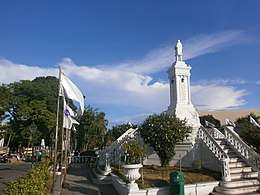 Rizal Monument at Town Plaza
Rizal Monument at Town Plaza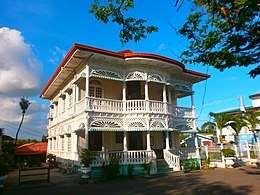 Carcar City Museum (formerly, Carcar Dispensary)
Carcar City Museum (formerly, Carcar Dispensary)- Carcar Church Interior
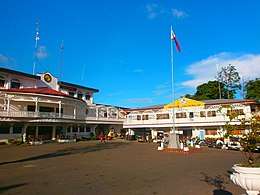 Carcar Town Complex
Carcar Town Complex
References
- "City". Quezon City, Philippines: Department of the Interior and Local Government. Retrieved 30 May 2013.
- "Province: Cebu". PSGC Interactive. Quezon City, Philippines: Philippine Statistics Authority. Retrieved 12 November 2016.
- Census of Population (2015). "Region VII (Central Visayas)". Total Population by Province, City, Municipality and Barangay. PSA. Retrieved 20 June 2016.
- "PSA releases the 2015 Municipal and City Level Poverty Estimates". Quezon City, Philippines. Retrieved 12 October 2019.
- Sun–Star 2005.
- Census of Population and Housing (2010). "Region VII (Central Visayas)". Total Population by Province, City, Municipality and Barangay. NSO. Retrieved 29 June 2016.
- "Carcar: Average Temperatures and Rainfall". Meteoblue. Retrieved 10 May 2020.
- Censuses of Population (1903–2007). "Region VII (Central Visayas)". Table 1. Population Enumerated in Various Censuses by Province/Highly Urbanized City: 1903 to 2007. NSO.
- "Province of Cebu". Municipality Population Data. Local Water Utilities Administration Research Division. Retrieved 17 December 2016.
Sources
| Wikisource has the text of a 1911 Encyclopædia Britannica article about Carcar. |
- Sun–Star (8 October 2005). "RDC enlarges Metro Cebu". Archived from the original on 30 September 2007. Retrieved 10 November 2015.CS1 maint: ref=harv (link)
External links


- Carcar Profile at PhilAtlas.com
- Philippine Standard Geographic Code
- DTI Cebu - Carcar
